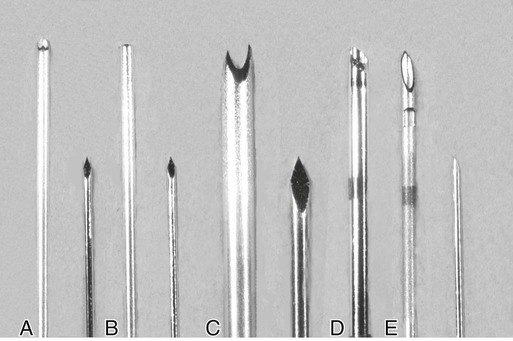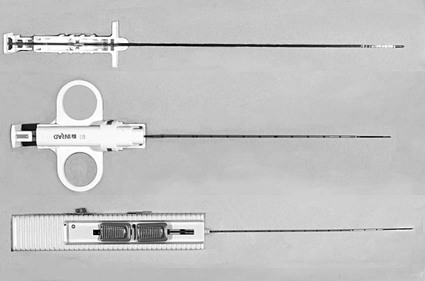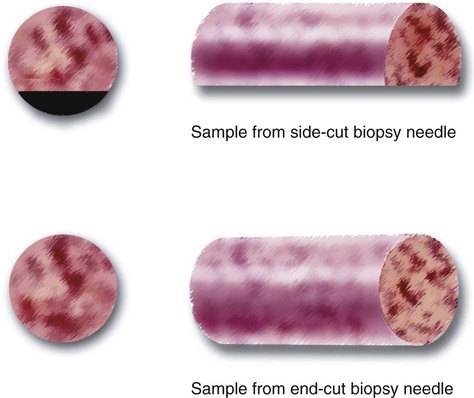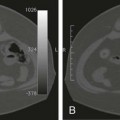The various devices used for soft-tissue biopsy of abdominal, thoracic, and other lesions can be classified on the basis of sampling mechanisms and needle tip configurations. Such devices include aspiration needles and small and large cutting core biopsy needles.1 Selection of biopsy device is based on patient history, location of the lesion, imaging appearance of the mass, intended trajectory of the needle, and importantly, the type of information sought from the pathologic sample. Coagulation status, proximity to vital structures, and expertise of the radiologist also play a role in needle selection. These needles can be used alone or coaxially with guide needles when multiple specimens are needed. Aspiration needles are the most frequently used biopsy needles to obtain samples primarily for cytologic analysis. They are commonly used by both radiologists and clinicians and include the spinal needle and the Chiba needle (Figs. 125-1 and 125-2). These needles are simple smaller-gauge beveled needles that have a noncutting edge. The Chiba needle is a thin-walled straight needle with a beveled tip angle of 30 degrees as described originally.2 It is made of stainless steel, has a removable stylet, and is available in 18- to 25-gauge sizes (Cook Medical, Bloomington, Ind.). When compared with Chiba needles, spinal needles have a smaller inner lumen and thicker wall, which makes them easier to control than a comparable gauge Chiba needle. They are also available in multiple sizes. The mechanism of sampling with aspiration needles is rapid to-and-fro movement with simultaneous rotation in the tissue/lesion and the application of suction with a syringe. This motion is continued for a maximum of 10 passes or until blood is obtained in the needle hub. Suction with the syringe is released as the needle is withdrawn to obtain material for cytologic examination. A variety of techniques and devices developed to help aspirate specimens in the needle are available but offer no significant advantage over manual aspiration.3 The vanSonnenberg needle set (Cook Medical) has a trocar point introducer needle with a removable hub, an outer cannula, and a 30-degree beveled-tip biopsy needle. A 23-gauge needle with a removable hub is used for a modified coaxial biopsy technique. The needle is useful for biopsy of small (≤2.5 cm) and difficult chest or abdominal lesions near vital structures. After removal of the hub, coaxial insertion of an outer 19-gauge needle is performed. Cutting biopsy or aspirated specimens are obtained coaxially through the 19-gauge needle after the hubless needle is removed. This system allows improved precision for smaller lesions, for which the tandem biopsy technique is not practical.4 Cutting biopsy needles are specifically designed to provide samples for histologic analysis. These needles remove small pieces of target tissue (0.1-0.4 mm and under) rather than cells. The various cutting mechanisms include end-cutting and side-cutting needles. Side-cutting needles generally work best with soft-tissue masses, whereas end-cutting needles do well in more solid lesions.1 End-cutting needles are basically aspiration needles with sharpened cutting tips and varying bevel angles and stylet configurations (see Figs. 125-1 and 125-2). The simplest of these is the Menghini-type needle (Cardinal Health, Woodstock, Ill.), an end-cutting device that has a sharpened beveled convex tip angled at 45 degrees.5 This configuration cuts out a cylinder of tissue on forward movement of the needle, without any rotation. The Turner needle (Cook Medical) has a circumferentially sharpened beveled tip with an angle of 45 degrees. When advanced and rotated in conjunction with suction through a syringe, the tip obtains an excellent core of tissue with minimal trauma.6 The Franseen needle (Cook Medical) is a trocar-point needle with three sharp bevels at the tip that act like cutting teeth once the inner stylet is withdrawn and the needle is rotated.7 The Madayag (Popper & Sons, New York, N.Y.) and the Greene (Cook Medical) needles have a sharpened 90-degree beveled tip with different stylet configurations. The Madayag needle has a conical stylet, whereas the Greene needle has a faceted stylet.8 The Westcott needle (Becton-Dickinson, Franklin Lakes, N.J.) is a modified side- and end-cutting needle with a slot measuring 2.2 mm in length located 3 mm from the tip of the needle. The slot creates a cutting edge in addition to the needle tip and enables aspiration of larger amounts of biopsy tissue.9 One of the most commonly used needles for core biopsy today is the Tru-Cut needle (Baxter Healthcare, Deerfield, Ill.). It is a side-cutting needle that consists of an outer cutting cannula and an inner slotted stylet (Fig. 125-3). After insertion of the needle tip to the edge of the tissue to be sampled, the inner slotted stylet is advanced and followed by the outer cutting cannula, which slices a piece of the tissue being sampled (Fig. 125-4). The throw of the stylet and slot length (and thus sample size) vary from 17 to 23 mm, depending on various vendors. The needle comes in manual and spring-loaded semiautomated and fully automated configurations (Fig. 125-5). Automated biopsy devices offer a semiautomated or fully automated loading and deployment spring-activated mechanism for side-cutting and end-cutting needles. Automated Tru-Cut–style needles include the ASAP biopsy needle (Medi-Tech/Boston Scientific, Natick, Mass.) and the Max-Core (C.R. Bard Inc., Tempe, Ariz.). Reusable fully automated side cut-type biopsy devices that are used with disposable needles are also available. The BioPince full-core biopsy needle (Inter-V, Gainesville, Fla.) is an automated end-cutting needle (see Fig. 125-3). It has a variable throw length of 13, 23, and 33 mm, which yields a specimen length of 9, 19, and 29 mm, respectively. The biopsy specimen obtained is a full cylindrical core, unlike side-cutting devices, which obtain a semi-cylindrical specimen (Figs. 125-6 and 125-7). Selection of a biopsy needle is generally guided by familiarity of the radiologist with the various needle types and the tissue being sampled. The size and design of the needle in addition to the biopsy technique and nature of the tissue are important factors contributing to the amount and quality of tissue retrieved.10 The thin noncutting aspiration needles are the safest devices available for biopsy, although their use has been associated with complications.1,11 Cutting needles are generally superior to aspiration needles and offer increased diagnostic accuracy with no significant difference in complication rates.1,12,13 In general, complication rates with the various biopsy devices have been reduced significantly because of improved imaging localization and procedure techniques and are currently less than 1%. Fine-needle aspiration biopsy has high cancer-specific diagnostic accuracy, but the accuracy of cancer-negative diagnoses is generally much lower. Moreover, diagnosis of the cancer cell type is also sometimes difficult to assess, such as with poorly differentiated cancer and lymphoma. The advantage of aspiration needles lies in the minimal tissue disruption they cause. They primarily divide tissue planes rather than severing tissue.14 Increased gauge and decreased bevel angle increase the diagnostic yield, and larger Chiba needles have a higher yield than similar smaller needles.10,15 With the collaboration of a cytopathologist during biopsy, however, fine-needle aspiration biopsy has diagnostic rates and accuracy comparable to that achieved with larger needles.16 The smaller-gauge needles can be used to traverse bowel or vessels safely without significantly increasing the risk of complications, but they are more flexible and thus more difficult to control when used for biopsy of deep-seated small lesions. Complications commonly occur when multiple needle passes are made or when used for biopsy of vascular lesions. Bleeding is one of the most frequent complications with larger-gauge needles (≥16 gauge); such needles are associated with greater bleeding than 18-gauge or smaller needles even in patients taking anticoagulants.14 Cutting needles have been recommended for biopsy of lesions with an unknown primary, evaluation of suspected benign disease, biopsy of possible second primary cancer, suspected lymphoma, and biopsy after nondiagnostic fine-needle aspiration.1 Cutting needles with a larger caliber obtain more tissue than smaller needles and are safe to use because fewer passes are required to obtain the same amount of diagnostic tissue.17 Low overall complication rates are seen with their use in the abdomen, and complication rates are higher with biopsy of the adrenal gland and pancreas than with biopsy of the liver.18 Under CT guidance, the yield of diagnostic tissue is higher with cutting needles, with no significant increase in complication rates over aspiration biopsy needles, even when larger needles are used.13
Biopsy Devices
Soft-Tissue Biopsy Devices
Aspiration Needles
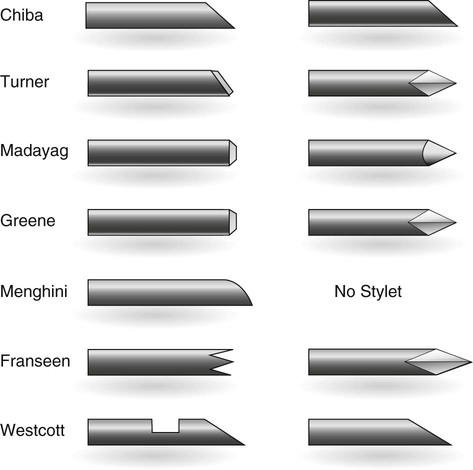
Cutting Needles
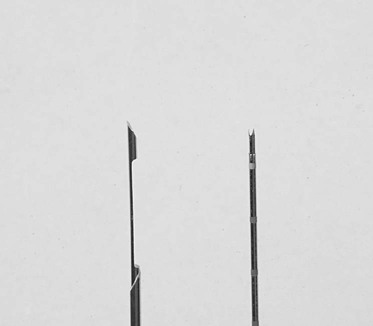
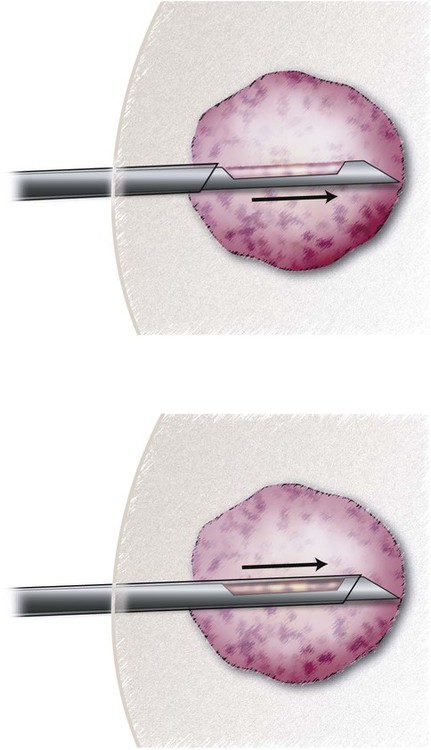
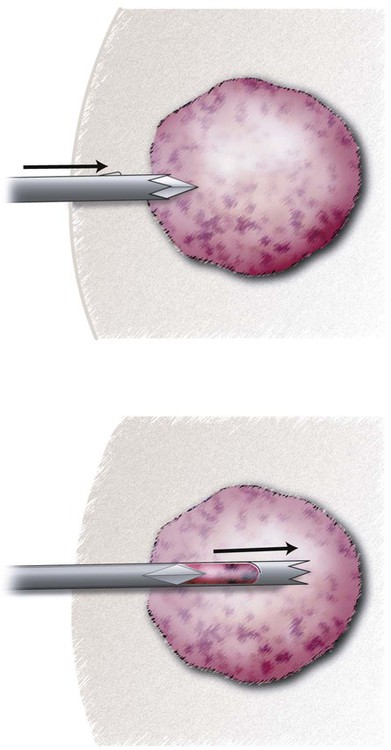
Comparison of Biopsy Devices
Aspiration Needle versus Cutting Needle
Biopsy Devices

